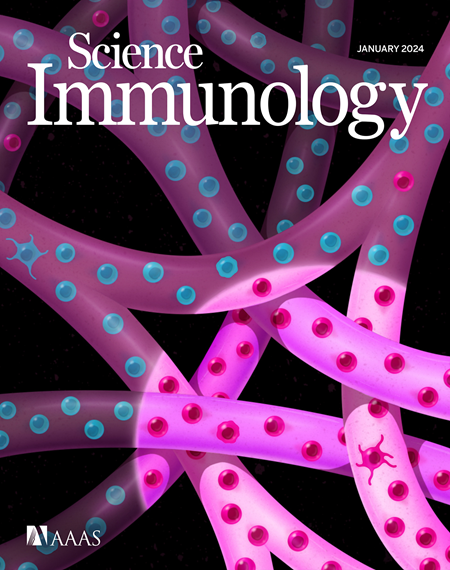不同的I型和II型干扰素反应直接胸腺皮层和髓质上皮细胞的发育
IF 17.6
1区 医学
Q1 IMMUNOLOGY
引用次数: 0
摘要
基因组学的进步重新定义了我们对胸腺上皮异质性和结构的理解,但驱动胸腺上皮分化的信号仍然不完全清楚。在这里,我们阐明了指导人类胸腺上皮细胞在其他前前叶来源器官中发育的途径。干扰素反应基因调控网络的激活将胸腺上皮细胞与其他前前肠来源器官的上皮细胞区分开来。胸腺皮层和髓质上皮表现出独特的干扰素应答特征,这是由谱系特异性染色质可及性定义的。我们探讨了I型和II型干扰素对诱导多能干细胞胸腺上皮祖细胞分化的影响。II型干扰素是表达蛋白酶体和抗原提呈分子所必需的,而I型或II型干扰素是诱导胸腺上皮祖细胞中不同细胞因子所必需的。我们的研究结果表明,干扰素对胸腺皮质和髓质上皮细胞分化至关重要。本文章由计算机程序翻译,如有差异,请以英文原文为准。
Distinct type I and II interferon responses direct cortical and medullary thymic epithelial cell development
Advances in genomics have redefined our understanding of thymic epithelial heterogeneity and architecture, yet signals driving thymic epithelial differentiation remain incompletely understood. Here, we elucidated pathways instructing human thymic epithelial cell development in the context of other anterior foregut–derived organs. Activation of interferon response gene regulatory networks distinguished epithelial cells of the thymus from those of other anterior foregut–derived organs. Thymic cortex and medulla epithelia displayed distinctive interferon-responsive signatures defined by lineage-specific chromatin accessibility. We explored the effects of type I and II interferons on thymic epithelial progenitor differentiation from induced pluripotent stem cells. Type II interferon was essential for expressing proteasome and antigen-presenting molecules, whereas type I or II interferons were essential for inducing different cytokines in thymic epithelial progenitor cells. Our findings suggest that interferons are critical to cortical and medullary thymic epithelial cell differentiation.
求助全文
通过发布文献求助,成功后即可免费获取论文全文。
去求助
来源期刊

Science Immunology
Immunology and Microbiology-Immunology
CiteScore
32.90
自引率
2.00%
发文量
183
期刊介绍:
Science Immunology is a peer-reviewed journal that publishes original research articles in the field of immunology. The journal encourages the submission of research findings from all areas of immunology, including studies on innate and adaptive immunity, immune cell development and differentiation, immunogenomics, systems immunology, structural immunology, antigen presentation, immunometabolism, and mucosal immunology. Additionally, the journal covers research on immune contributions to health and disease, such as host defense, inflammation, cancer immunology, autoimmunity, allergy, transplantation, and immunodeficiency. Science Immunology maintains the same high-quality standard as other journals in the Science family and aims to facilitate understanding of the immune system by showcasing innovative advances in immunology research from all organisms and model systems, including humans.
 求助内容:
求助内容: 应助结果提醒方式:
应助结果提醒方式:


